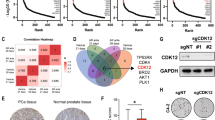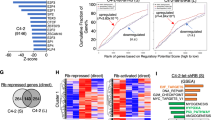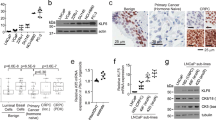Abstract
Treatment of prostate cancer (PC) by androgen suppression promotes the emergence of aggressive variants that are androgen receptor (AR) independent. Here we identify the transcription factor ONECUT2 (OC2) as a master regulator of AR networks in metastatic castration-resistant prostate cancer (mCRPC). OC2 acts as a survival factor in mCRPC models, suppresses the AR transcriptional program by direct regulation of AR target genes and the AR licensing factor FOXA1, and activates genes associated with neural differentiation and progression to lethal disease. OC2 appears active in a substantial subset of human prostate adenocarcinoma and neuroendocrine tumors. Inhibition of OC2 by a newly identified small molecule suppresses metastasis in mice. These findings suggest that OC2 displaces AR-dependent growth and survival mechanisms in many cases where AR remains expressed, but where its activity is bypassed. OC2 is also a potential drug target in the metastatic phase of aggressive PC.
This is a preview of subscription content, access via your institution
Access options
Access Nature and 54 other Nature Portfolio journals
Get Nature+, our best-value online-access subscription
$29.99 / 30 days
cancel any time
Subscribe to this journal
Receive 12 print issues and online access
$209.00 per year
only $17.42 per issue
Buy this article
- Purchase on Springer Link
- Instant access to full article PDF
Prices may be subject to local taxes which are calculated during checkout






Similar content being viewed by others
Data availability
Data generated or analyzed during this study are included in this published article (and its supplementary information files). ChIP-seq and microarray data generated in this study were deposited in GEO (GSE97551, GSE97548, GSE97549). The DISC cohort data are available at www.thepcta.org.
References
Beltran, H. et al. Aggressive variants of castration-resistant prostate cancer. Clin. Cancer Res. 20, 2846–2850 (2014).
Gundem, G. et al. The evolutionary history of lethal metastatic prostate cancer. Nature 520, 353–357 (2015).
Chang, K. H. et al. Dihydrotestosterone synthesis bypasses testosterone to drive castration-resistant prostate cancer. Proc. Natl Acad. Sci. USA 108, 13728–13733 (2011).
Sharma, N. L. et al. The androgen receptor induces a distinct transcriptional program in castration-resistant prostate cancer in man. Cancer Cell 23, 35–47 (2013).
Kumar, A. et al. Substantial interindividual and limited intraindividual genomic diversity among tumors from men with metastatic prostate cancer. Nat. Med. 22, 369–378 (2016).
Niu, Y. et al. Androgen receptor is a tumor suppressor and proliferator in prostate cancer. Proc. Natl Acad. Sci. USA 105, 12182–12187 (2008).
Espana, A. & Clotman, F. Onecut factors control development of the Locus Coeruleus and of the mesencephalic trigeminal nucleus. Mol. Cell. Neurosci. 50, 93–102 (2012).
Jacquemin, P., Lannoy, V. J., Rousseau, G. G. & Lemaigre, F. P. OC-2, a novel mammalian member of the ONECUT class of homeodomain transcription factors whose function in liver partially overlaps with that of hepatocyte nuclear factor-6. J. Biol. Chem. 274, 2665–2671 (1999).
Vanhorenbeeck, V. et al. Role of the Onecut transcription factors in pancreas morphogenesis and in pancreatic and enteric endocrine differentiation. Dev. Biol. 305, 685–694 (2007).
Leyten, G. H. et al. Identification of a candidate gene panel for the early diagnosis of prostate cancer. Clin. Cancer Res. 21, 3061–3070 (2015).
Guo, H. et al. Modulation of long noncoding RNAs by risk SNPs underlying genetic predispositions to prostate cancer. Nat. Genet. 48, 1142–1150 (2016).
You, S. et al. Integrated classification of prostate cancer reveals a novel luminal subtype with poor outcome. Cancer Res. 76, 4948–4958 (2016).
Xu, K. et al. EZH2 oncogenic activity in castration-resistant prostate cancer cells is Polycomb-independent. Science 338, 1465–1469 (2012).
Levine, D. M. et al. Pathway and gene-set activation measurement from mRNA expression data: the tissue distribution of human pathways. Genome Biol. 7, R93 (2006).
D’Antonio, J. M., Ma, C., Monzon, F. A. & Pflug, B. R. Longitudinal analysis of androgen deprivation of prostate cancer cells identifies pathways to androgen independence. Prostate 68, 698–714 (2008).
Mulholland, D. J. et al. Pten loss and RAS/MAPK activation cooperate to promote EMT and metastasis initiated from prostate cancer stem/progenitor cells. Cancer Res. 72, 1878–1889 (2012).
Cai, C. et al. Androgen receptor gene expression in prostate cancer is directly suppressed by the androgen receptor through recruitment of lysine-specific demethylase 1. Cancer Cell. 20, 457–471 (2011).
Hu, R. et al. Ligand-independent androgen receptor variants derived from splicing of cryptic exons signify hormone-refractory prostate cancer. Cancer Res. 69, 16–22 (2009).
Shukla, S. et al. Aberrant activation of a gastrointestinal transcriptional circuit in prostate cancer mediates castration resistance. Cancer Cell. 32, 792–806.e7 (2017).
Liberzon, A. et al. The Molecular Signatures Database (MSigDB) hallmark gene set collection. Cell Syst. 1, 417–425 (2015).
Griffon, A. et al. Integrative analysis of public ChIP-seq experiments reveals a complex multi-cell regulatory landscape. Nucleic Acids Res. 43, e27 (2015).
Cleutjens, K. B. et al. An androgen response element in a far upstream enhancer region is essential for high, androgen-regulated activity of the prostate-specific antigen promoter. Mol. Endocrinol. 11, 148–161 (1997).
Latham, J. P., Searle, P. F., Mautner, V. & James, N. D. Prostate-specific antigen promoter/enhancer driven gene therapy for prostate cancer: construction and testing of a tissue-specific adenovirus vector. Cancer Res. 60, 334–341 (2000).
Jin, H. J., Zhao, J. C., Wu, L., Kim, J. & Yu, J. Cooperativity and equilibrium with FOXA1 define the androgen receptor transcriptional program. Nat. Commun. 5, 3972 (2014).
Kim, J. et al. FOXA1 inhibits prostate cancer neuroendocrine differentiation. Oncogene 36, 4072–4080 (2017).
Beltran, H. et al. Divergent clonal evolution of castration-resistant neuroendocrine prostate cancer. Nat. Med. 22, 298–305 (2016).
Barretina, J. et al. The Cancer Cell Line Encyclopedia enables predictive modelling of anticancer drug sensitivity. Nature 483, 603–607 (2012).
Grozinsky-Glasberg, S., Shimon, I. & Rubinfeld, H. The role of cell lines in the study of neuroendocrine tumors. Neuroendocrinology 96, 173–187 (2012).
Shiau, C. K., Gu, D. L., Chen, C. F., Lin, C. H. & Jou, Y. S. IGRhCellID: integrated genomic resources of human cell lines for identification. Nucleic Acids Res. 39, D520–D524 (2011).
Wong, C., & Vosburgh, E. & Levine, A. J. & Cong, L. & Xu, E. Y. Human neuroendocrine tumor cell lines as a three-dimensional model for the study of human neuroendocrine tumor therapy. J. Vis. Exp. (66), e4218 (2012).
Parimi, V., Goyal, R., Poropatich, K. & Yang, X. J. Neuroendocrine differentiation of prostate cancer: a review. Am. J. Clin. Exp. Urol. 2, 273–285 (2014).
Roudier, M. P. et al. Phenotypic heterogeneity of end-stage prostate carcinoma metastatic to bone. Hum. Pathol. 34, 646–653 (2003).
Nguyen, H. M. et al. LuCaP Prostate cancer patient-derived xenografts reflect the molecular heterogeneity of advanced disease and serve as models for eEvaluating cancer therapeutics. Prostate 77, 654–671 (2017).
Lapuk, A. V. et al. From sequence to molecular pathology, and a mechanism driving the neuroendocrine phenotype in prostate cancer. J. Pathol. 227, 286–297 (2012).
Akamatsu, S. et al. The placental gene PEG10 promotes progression of neuroendocrine prostate cancer. Cell Reports 12, 922–936 (2015).
Gao, D. et al. Organoid cultures derived from patients with advanced prostate cancer. Cell 159, 176–187 (2014).
Wyatt, A. W. et al. Heterogeneity in the inter-tumor transcriptome of high risk prostate cancer. Genome Biol. 15, 426 (2014).
Robinson, D. et al. Integrative clinical genomics of advanced prostate cancer. Cell 161, 1215–1228 (2015).
Taylor, B. S. et al. Integrative genomic profiling of human prostate cancer. Cancer Cell. 18, 11–22 (2010).
Epstein, J. I. et al. Proposed morphologic classification of prostate cancer with neuroendocrine differentiation. Am. J. Surg. Pathol. 38, 756–767 (2014).
Zou, M. et al. Transdifferentiation as a mechanism of treatment resistance in a mouse model of castration-resistant prostate cancer. Cancer Discov. 7, 736–749 (2017).
Sun, Y. et al. MiR-429 inhibits cells growth and invasion and regulates EMT-related marker genes by targeting Onecut2 in colorectal carcinoma. Mol. Cell. Biochem. 390, 19–30 (2014).
Bolstad, B. M., Irizarry, R. A., Astrand, M. & Speed, T. P. A comparison of normalization methods for high density oligonucleotide array data based on variance and bias. Bioinformatics 19, 185–193 (2003).
Hwang, D. et al. A data integration methodology for systems biology. Proc. Natl Acad. Sci. USA 102, 17296–17301 (2005).
Storey, J. D. & Tibshirani, R. Statistical significance for genomewide studies. Proc. Natl Acad. Sci. USA 100, 9440–9445 (2003).
Kharchenko, P. V., Tolstorukov, M. Y. & Park, P. J. Design and analysis of ChIP-seq experiments for DNA-binding proteins. Nat. Biotechnol. 26, 1351–1359 (2008).
Li, H. & Durbin, R. Fast and accurate short read alignment with Burrows-Wheeler transform. Bioinformatics 25, 1754–1760 (2009).
Kharchenko, P. V., Tolstorukov, M. Y. & Park, P. J. Design and analysis of ChIP-seq experiments for DNA-binding proteins. Nat. Biotechnol. 26, 1351–1359 (2008).
Ramirez, F. et al. deepTools2: a next generation web server for deep-sequencing data analysis. Nucleic Acids Res. 44, W160–W165 (2016).
Yu, G., Wang, L. G. & He, Q. Y. ChIPseeker: an R/Bioconductor package for ChIP peak annotation, comparison and visualization. Bioinformatics 31, 2382–2383 (2015).
Yu, G., Wang, L. G., Yan, G. R. & He, Q. Y. DOSE: an R/Bioconductor package for disease ontology semantic and enrichment analysis. Bioinformatics 31, 608–609 (2015).
Bailey, T. L. et al. MEME SUITE: tools for motif discovery and searching. Nucleic Acids Res. 37, W202–W208 (2009).
Rotinen, M. et al. Estradiol induces type 8 17β-hydroxysteroid dehydrogenase expression: crosstalk between estrogen receptor α and C/EBPβ. J. Endocrinol. 200, 85–92 (2009).
Iyaguchi, D., Yao, M., Watanabe, N., Nishihira, J. & Tanaka, I. DNA recognition mechanism of the ONECUT homeodomain of transcription factor HNF-6. Structure 15, 75–83 (2007).
Arnold, K., Bordoli, L., Kopp, J. & Schwede, T. The SWISS-MODEL workspace: a web-based environment for protein structure homology modelling. Bioinformatics 22, 195–201 (2006).
Biasini, M. et al. SWISS-MODEL: modelling protein tertiary and quaternary structure using evolutionary information. Nucleic Acids Res. 42, W252–W258 (2014).
Morin, A. et al. Collaboration gets the most out of software. eLife 2, e01456 (2013).
Acknowledgments
This study was supported by Department of Defense (DOD) grant no. W81XWH-16-1-0567 (M.R.F); NCI grant no. 1R01CA143777 (M.R.F.); NCI grant no. 1R01CA220327 (M.R.F. and S.J.F.); NIDDK grant no. 1R01DK087806 (M.R.F.); Prostate Cancer Foundation Challenge Grant grant no. 17CHAL04 (I.P.G.); Spielberg Discovery Fund in Prostate Cancer Research (B.S.K. and M.R.F.); NCI grant no. 2P01CA098912 (L.W.K.C.); Jean Perkins Foundation (I.P.G.); Movember/PCR GAP1 Unique TMAs Project (I.P.G.); DOD grant no. PC131996 (I.P.G.); DOD grant no. PC130244 (I.P.G.); NCI grant no. U54 CA143931 (I.P.G.); DOD grant no. W81XWH-14-1-0152 (S.Y.); Urology Care Foundation Research Scholar Award and Chesapeake Urology Associates Research Scholar Fund (M.R.); 2018 Donna and Jesse Garber Award for Cancer Research, Samuel Oschin Comprehensive Cancer Institute, Cedars-Sinai Medical Center (M.R.); Urology Care Foundation Research Scholars Program of AUA Western Section Research Scholar Fund (S.Y.). The authors are very appreciative of technical and conceptual contributions from N. Bhowmick, R. Matusik, V. Placencio, K. Kelly, M. Beshiri, W.R. Wiedemeyer, P.J. Aspuria, C. Spinelli, H. Soule, and the Biobank & Translational Research Core at Cedars-Sinai Medical Center.
Author information
Authors and Affiliations
Contributions
Conceptualization, M.R., S.Y., and M.R.F. Methodology, M.R., S.Y., and M.R.F. Investigation, M.R., S.Y., J.Y., M.R.-S., W.-C.H., X.P., A.Y., K.S., C.Y.C., L.W.K.C, and M.R.F. Software, S.Y., S.G.C, F.H., and D.J.H. Validation and formal analysis, M.R. and S.Y. Visualization, M.R., S.Y., and M.R.F. Project administration, M.R.F. Data curation, S.Y. and S.G.C. Resources, B.K., I.P.G., C.M.M., P.S.N., and E.C. Writing original draft, M.R, S.Y., and M.R.F. Writing, review, and editing, B.S.K., I.P.G., L.W.C.K., S.J.F., D.D.V., R.M., M.R, S.Y., and M.R.F. Funding acquisition, M.R., S.Y., I.P.G., B.S.K., and M.R.F. Supervision, M.R.F.
Corresponding author
Ethics declarations
Competing interests
Cedars-Sinai Medical Center has pending patent applications PCT/US2017/034768 (M.R.F., M.R., R.M., and S.Y.) and US62/548,879 (M.R.F., M.R., R.M., and S.Y.) relevant to this study.
Additional information
Publisher’s note: Springer Nature remains neutral with regard to jurisdictional claims in published maps and institutional affiliations.
Supplementary information
Supplementary Text and Figures
Supplementary Figures 1–9 and Supplementary Tables 1 and 2
Rights and permissions
About this article
Cite this article
Rotinen, M., You, S., Yang, J. et al. ONECUT2 is a targetable master regulator of lethal prostate cancer that suppresses the androgen axis. Nat Med 24, 1887–1898 (2018). https://doi.org/10.1038/s41591-018-0241-1
Received:
Accepted:
Published:
Issue Date:
DOI: https://doi.org/10.1038/s41591-018-0241-1
This article is cited by
-
The yin and yang of chromosomal instability in prostate cancer
Nature Reviews Urology (2024)
-
Decoding the basis of histological variation in human cancer
Nature Reviews Cancer (2024)
-
Targeting ONECUT3 blocks glycolytic metabolism and potentiates anti-PD-1 therapy in pancreatic cancer
Cellular Oncology (2024)
-
Mechanism-centric regulatory network identifies NME2 and MYC programs as markers of Enzalutamide resistance in CRPC
Nature Communications (2024)
-
Epigenetic mechanisms underlying subtype heterogeneity and tumor recurrence in prostate cancer
Nature Communications (2023)



